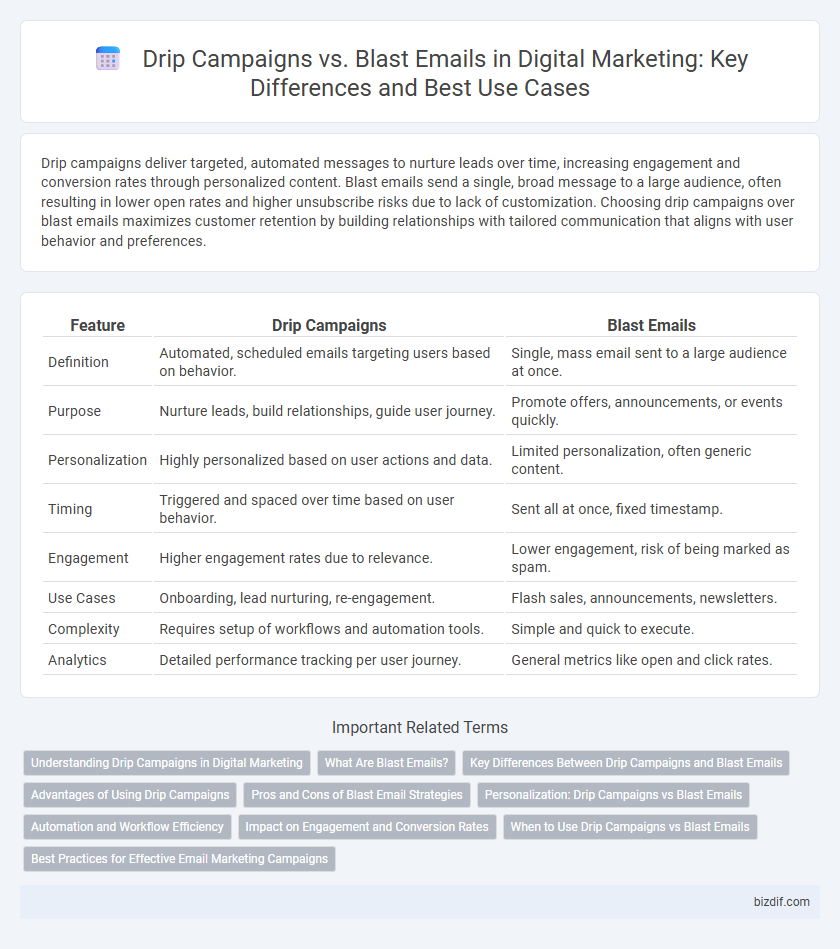Drip campaigns deliver targeted, automated messages to nurture leads over time, increasing engagement and conversion rates through personalized content. Blast emails send a single, broad message to a large audience, often resulting in lower open rates and higher unsubscribe risks due to lack of customization. Choosing drip campaigns over blast emails maximizes customer retention by building relationships with tailored communication that aligns with user behavior and preferences.
Table of Comparison
| Feature | Drip Campaigns | Blast Emails |
|---|---|---|
| Definition | Automated, scheduled emails targeting users based on behavior. | Single, mass email sent to a large audience at once. |
| Purpose | Nurture leads, build relationships, guide user journey. | Promote offers, announcements, or events quickly. |
| Personalization | Highly personalized based on user actions and data. | Limited personalization, often generic content. |
| Timing | Triggered and spaced over time based on user behavior. | Sent all at once, fixed timestamp. |
| Engagement | Higher engagement rates due to relevance. | Lower engagement, risk of being marked as spam. |
| Use Cases | Onboarding, lead nurturing, re-engagement. | Flash sales, announcements, newsletters. |
| Complexity | Requires setup of workflows and automation tools. | Simple and quick to execute. |
| Analytics | Detailed performance tracking per user journey. | General metrics like open and click rates. |
Understanding Drip Campaigns in Digital Marketing
Drip campaigns in digital marketing are automated, targeted email sequences designed to nurture leads through personalized content over time, resulting in higher engagement and conversion rates compared to blast emails. Unlike blast emails, which send a single message to a broad audience, drip campaigns deliver timely, relevant messages based on user behavior and preferences, enhancing customer journey optimization. This strategic approach allows marketers to build stronger relationships with prospects by consistently providing valuable information aligned with their needs and purchase intent.
What Are Blast Emails?
Blast emails are mass messages sent to a large audience simultaneously, designed to promote products, services, or announcements rapidly. These emails typically lack personalization and are used for time-sensitive campaigns that require fast widespread reach. Marketers rely on blast emails for broad exposure, but they may experience lower engagement rates compared to targeted drip campaigns.
Key Differences Between Drip Campaigns and Blast Emails
Drip campaigns deliver personalized, automated messages to targeted segments over time, enhancing customer engagement through tailored content based on user behavior and preferences. Blast emails send a single, mass email to a wide audience, prioritizing speed and broad reach but often resulting in lower open and conversion rates due to lack of segmentation. Drip campaigns typically achieve higher ROI by nurturing leads and building relationships, while blast emails are effective for time-sensitive promotions and announcements.
Advantages of Using Drip Campaigns
Drip campaigns offer personalized, automated communication that nurtures leads through targeted content based on user behavior and engagement, resulting in higher conversion rates. Unlike blast emails, drip campaigns maintain consistent touchpoints, reducing unsubscribes and increasing brand loyalty by delivering timely, relevant messages. This strategy enhances campaign efficiency by leveraging marketing automation platforms to optimize customer journeys and improve overall ROI.
Pros and Cons of Blast Email Strategies
Blast email strategies excel in reaching large audiences quickly, boosting brand awareness and driving immediate action through timely promotions. However, these campaigns often suffer from lower engagement rates due to their generic content and higher risk of being marked as spam. Maintaining list hygiene and segmenting contacts can partially mitigate these drawbacks, but personalization remains limited compared to drip campaigns.
Personalization: Drip Campaigns vs Blast Emails
Drip campaigns leverage advanced segmentation and behavioral triggers to deliver highly personalized content, increasing engagement and conversion rates by addressing individual customer journeys. In contrast, blast emails send uniform messages to large audiences, resulting in lower personalization and higher chances of disengagement. Personalization in drip campaigns drives better ROI through targeted relevance, while blast emails often generate higher unsubscribe rates due to generic messaging.
Automation and Workflow Efficiency
Drip campaigns leverage automation to deliver personalized, timely content based on user behavior, enhancing lead nurturing and conversion rates. Blast emails, while useful for broad announcements, lack the targeted workflow efficiency achieved by segmented, automated drip sequences. Implementing drip campaigns streamlines marketing workflows by reducing manual intervention and improving engagement through relevant messaging.
Impact on Engagement and Conversion Rates
Drip campaigns deliver personalized, timely content to segmented audiences, significantly increasing engagement and boosting conversion rates by nurturing leads throughout the buyer's journey. Blast emails, while reaching a larger audience quickly, often result in lower engagement due to their generic messaging and lack of relevance. Data shows drip campaigns can improve open rates by up to 80% and conversions by 30% compared to single blast email sends.
When to Use Drip Campaigns vs Blast Emails
Drip campaigns are ideal for nurturing leads over time with personalized, sequenced content that aligns with the customer journey, increasing engagement and conversion rates. Blast emails work best for time-sensitive promotions or announcements that need immediate attention from a broad audience. Choosing between drip campaigns and blast emails depends on whether the goal is to build long-term relationships or to deliver quick, widespread messaging.
Best Practices for Effective Email Marketing Campaigns
Drip campaigns leverage automated, targeted email sequences to nurture leads over time, enhancing engagement through personalization and timely content delivery. Blast emails, while effective for broad announcements, require precise segmentation and compelling subject lines to avoid low open rates and spam filters. Implementing A/B testing, optimizing send times, and maintaining consistent branding are essential best practices for maximizing the impact of both drip campaigns and blast emails in digital marketing.
Drip campaigns vs Blast emails Infographic

 bizdif.com
bizdif.com